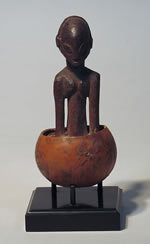Timbuktu to Cape Town
dal 2/12/2008 al 21/3/2009
Segnalato da
2/12/2008
Timbuktu to Cape Town
Cantor Arts Center, Stanford
The show celebrates the complexity and variety of African art from across the continent, with an array of the most important works acquired by the Center over the past 10 years. The works are grouped around 3 categories: objects that adorn the human body, objects related to the home, and those created for ritual use.

The Cantor Arts Center at Stanford University presents “Timbuktu to Cape Town,” December 3, 2008 - March 22, 2009. This exhibition celebrates the complexity and variety of African art from across the continent, with an array of the most important African works acquired by the Center over the past 10 years.
“The works are grouped loosely around three categories-objects that adorn the human body, objects related to the home, and those created for ritual use-although, in fact, their meanings and utility overlap and converge. A gown worn for state functions is embellished with protective religious symbols, a decorated door imbues the home with spiritual meaning. Traditional arts evolve as contemporary artists combine the old with the new, creating work that speaks in today's voice to today's global audiences,” explained Cantor Arts Center Director Thomas K. Seligman, who served as the curator of the exhibition. “We designed this to expand visitors' concepts and understandings of art in Africa, and these works reveal media and subject matter well beyond the figurative wooden sculpture and masks that often typify displays of African art.”
“Timbuktu to Cape Town” offers more than 50 works on view in the Center's Ruth Levison Halperin Gallery. The oldest is a 17th-century trumpet made of an elephant tusk, from the Sherbro culture of Sierra Leone. The most recent, created in 2005, is a photograph by contemporary Moroccan artist Lalla Essaydi, entitled “Converging Territories #31.” The remaining works are from the 19th and 20th centuries, including vessels of clay and ivory, silver and leather jewelry, and elaborately ornamented textiles, as well as a few stellar sculptural objects. Video and photographs of people and places enrich the installation and provide further context for the works.
“Timbuktu to Cape Town” is made possible by the Halperin Exhibitions Fund and the Phyllis Wattis Program Fund.
An annex to “Timbuktu to Cape Town” displays recently acquired figurative wooden sculptures, masks, and a reliquary guardian. Other traditional works are on view in the Center's African gallery on the first floor of the museum. At Stanford, African art has been collected since the founding family traveled to Egypt and brought back ancient material, including the ever-popular mummy. The Cantor Arts Center's collection of art from diverse African cultures supports Stanford University's expanded multi-disciplinary program in African Studies and the University's commitment to global understanding.
Cantor Arts Center
Stanford University 328 Lomita Drive and Museum Way - Stanford
Wednesday – Sunday, 11 am – 5 pm, Thursday until 8 pm
Admission is free



